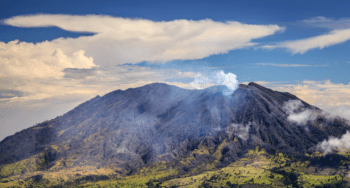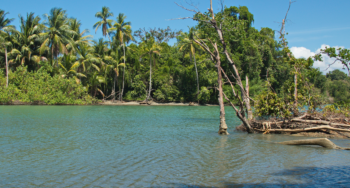Braulio Carrillo National Park: What's Covered
Braulio Carrillo National Park sits just 20km from San José, making it Costa Rica’s most accessible primary rainforest experience. Entry costs $15 for adults, with trails ranging from easy 1-hour loops to challenging 5-hour volcano hikes. The park opens 8 AM-4 PM daily. Any standard vehicle handles the well-maintained Highway 32 route, perfect for combining with Caribbean coast destinations.
Quick Facts:
- Three entrance sectors: Zurquí (main, best facilities), Quebrada González (fewer crowds), Barva (cloud forest, 4WD recommended).
- Best wildlife viewing is 7-9 AM, before animals retreat from midday heat.
- Covers 47,000 hectares with elevations from 36m to 2,896m, creating multiple climate zones.
- Green season (May-Nov) brings lush conditions; mornings stay dry before 1-2 PM, and rain.
- Over 400 bird species, sloths in cecropia trees, and howler monkeys are audible from miles away.
Top 3 Trails:
- Las Palmas – Easy 1.6km loop ideal for families, massive strangler fig highlight
- El Cecropia – Best sloth spotting on 3km trail named for their favorite trees
- Barva Loop – Challenging 8km cloud forest adventure to volcanic crater lakes
Perfect as a morning stop when driving to Puerto Viejo or as part of Central Valley exploration.
If you need any help with a Costa Rica car rental, contact us now!
Looking for Costa Rica’s most accessible rainforest experience? Braulio Carrillo National Park sits just 20 kilometers from San José, making it the perfect day trip for travelers wanting to experience primary rainforest without the long journey to more remote destinations.
Despite being Costa Rica’s third-largest national park, Braulio Carrillo remains surprisingly undervisited compared to Manuel Antonio or Arenal. This means you’ll often have trails largely to yourself while experiencing some of the country’s most pristine cloud and rainforest ecosystems.
The park’s proximity to the capital and position along the main highway to the Caribbean coast makes it an ideal stop for travelers heading to or from places like Puerto Viejo or Tortuguero. But don’t think of this as just a quick roadside break. Braulio Carrillo deserves at least half a day to appreciate its incredible biodiversity and well-maintained trail system.
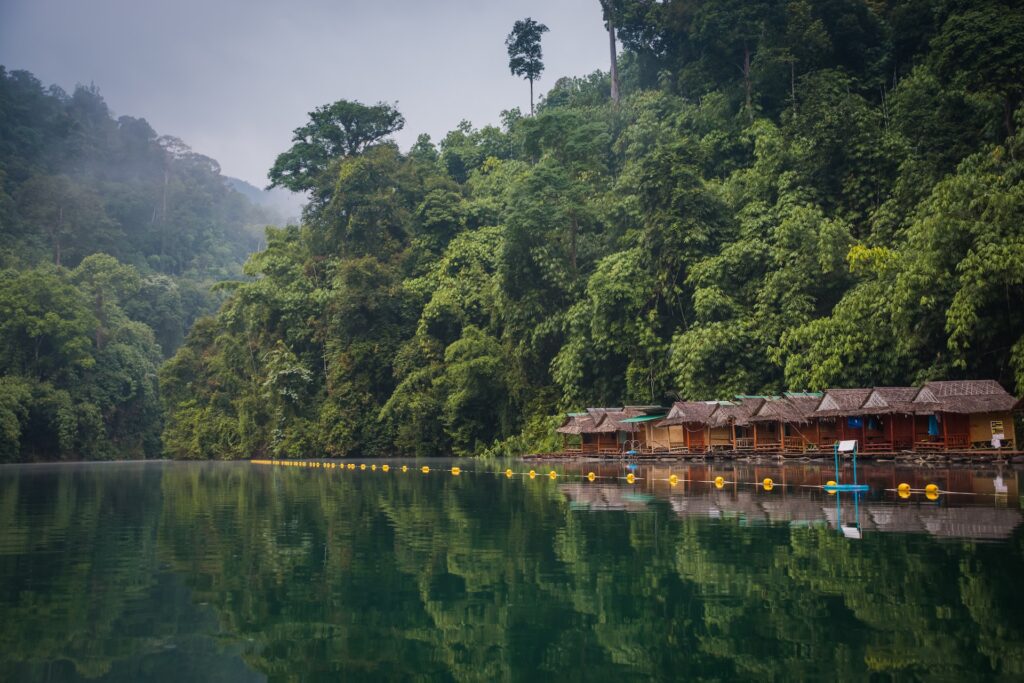
What Makes Braulio Carrillo Different from Other Parks?
Braulio Carrillo National Park protects a crucial biological corridor connecting Costa Rica’s Central Valley with the Caribbean lowlands. This position creates an exceptional range of ecosystems within a single park, from montane cloud forests at higher elevations to lowland rainforests near the Caribbean side.
The park covers 47,000 hectares (over 180 square miles) and ranges in elevation from 36 meters to 2,896 meters above sea level. This dramatic elevation change creates distinct microclimates and habitats, supporting an incredible diversity of plant and animal life.
Why Should You Care About Elevation Changes?
Unlike many Costa Rican national parks that focus on specific ecosystems, Braulio Carrillo showcases the country’s biological diversity in transition. You can literally experience multiple climate zones and forest types within a single visit. Start your morning in cool cloud forest conditions and descend into humid lowland rainforest by afternoon.
The park’s establishment in 1978 was specifically designed to preserve the watershed and forest corridors that were being threatened by development between San José and the Caribbean coast. Today, it serves as a green lung for the Central Valley and a critical habitat for species that migrate between different elevations.
This vertical migration is fascinating to witness. Birds that feed in the lowlands during certain seasons move to higher elevations when fruits ripen there. Mammals follow similar patterns, creating a dynamic ecosystem that changes throughout the year.
How Do You Actually Get to Braulio Carrillo?
Want to Drive from San José?
The drive to Braulio Carrillo’s main entrance takes about 45 minutes from central San José, following Highway 32 toward Limón. The road is well-paved and clearly marked, making this one of Costa Rica’s most accessible national parks.
Your route details: Take Highway 32 (Carretera Braulio Carrillo) northeast from San José. You’ll pass through Zurquí Tunnel – the longest tunnel in Central America at 468 meters. Watch for the clearly marked national park entrance signs. The total distance runs approximately 35 kilometers from downtown San José.
The road to Braulio Carrillo involves significant elevation changes as you climb from the Central Valley into the mountains. You’ll experience temperature drops and often encounter fog or light rain, even during the dry season. Pack a light jacket even if it’s warm in San José – temperatures can drop 10-15 degrees Fahrenheit as you climb.
Vehicle reality check: Any standard vehicle can easily reach the main park entrances. The park access roads are paved and well-maintained. However, if you’re planning to explore some of the more remote sections or combine your visit with other mountain destinations, a vehicle with good acceleration and reliable brakes is helpful for the steep, winding sections of Highway 32.
What About Public Transportation?
Several public buses travel Highway 32 daily, heading to Limón, Puerto Viejo, and other Caribbean destinations. Ask the driver to stop at the park entrance – most are familiar with the location and will accommodate your request.
Buses depart from San José’s Caribbean bus terminal (Terminal del Caribe) with multiple daily departures throughout the morning. The first buses leave around 5:30 AM, with regular service continuing until mid-afternoon. Return trips can be less frequent, so plan accordingly. Travel time runs approximately 1-1.5 hours including stops.
Bus travel tip: Sit on the right side of the bus heading toward the Caribbean for the best views of the forest and occasional glimpses into the canopy. The left side faces the rock wall for much of the journey.
Should You Consider a Guided Tour?
Many San José-based tour companies offer day trips to Braulio Carrillo, often combined with aerial tram experiences or other nearby attractions. These tours typically include transportation, guide services, and park entrance fees.
Tours usually depart around 7 AM from San José hotels, providing naturalist guides who can spot wildlife you’d likely miss on your own. The downside? You’re locked into their schedule and can’t linger at spots you find particularly interesting.
The advantage of having your own transportation becomes clear when you want to explore at your own pace or combine Braulio Carrillo with other destinations along the Caribbean route. You might spot interesting birds and want to spend an extra hour on a particular trail, or the weather might be perfect for continuing to the Caribbean coast.
Which Park Entrance Should You Choose?
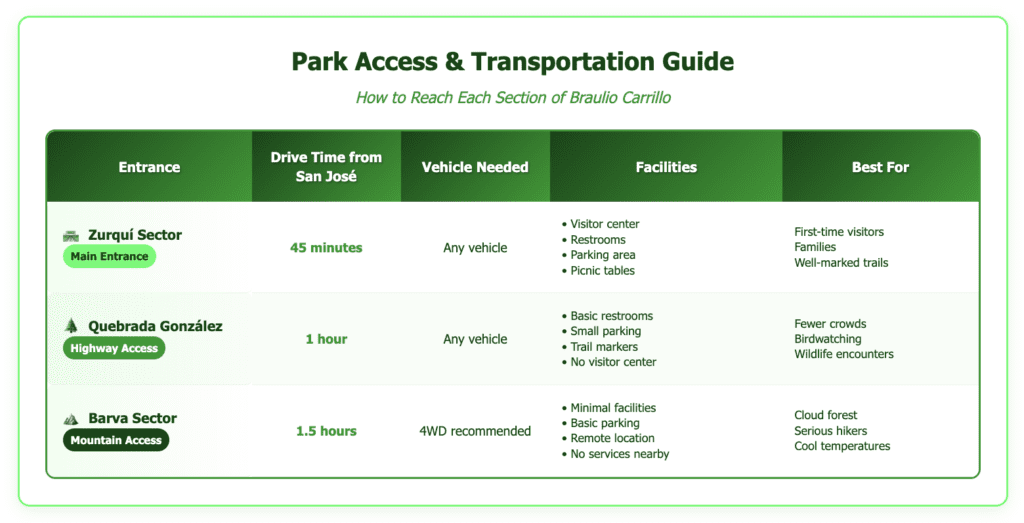
Braulio Carrillo has multiple entrance points, each offering different experiences and trail options. Choosing the right one depends on your fitness level, time available, and what you hope to see.
Is the Zurquí Sector Right for First-Time Visitors?
The most popular and accessible entrance, located directly off Highway 32. This sector offers the best infrastructure and most developed trail system.
You’ll find a visitor center with park information and exhibits about local ecology, clean restrooms and covered picnic areas, well-marked trailheads with distance markers, free parking with space for about 50 vehicles, and drinking water available at the visitor center. This entrance works best for first-time visitors, families, and those wanting well-maintained trails with good signage.
The visitor center opens at 8 AM sharp, and arriving early means cooler temperatures and more active wildlife. Park rangers here speak some English and can provide trail recommendations based on your fitness level and interests.
Why Choose Quebrada González Sector?
Located further along Highway 32, about 15 kilometers past the main entrance, this sector offers a different perspective and typically fewer crowds.
Expect more challenging trails with steeper inclines, excellent birdwatching opportunities especially for tanagers and toucans, less developed infrastructure (just basic restrooms), and better chances for wildlife encounters due to fewer visitors. If you’re looking to escape the main entrance crowds, this is your spot.
The Las Palmas trail here connects to a beautiful viewpoint overlooking the Hondura River canyon. On clear days, you can see all the way to the Caribbean lowlands – a view most visitors never experience.
What’s Special About the Barva Sector?
The highest elevation section, accessed via a different route through Heredia province. This area showcases true cloud forest conditions.
This sector requires separate transportation planning – it’s not directly on Highway 32. Instead, you’ll drive through Heredia, past coffee farms, and up increasingly narrow mountain roads. The final stretch definitely benefits from a 4WD vehicle, especially during the rainy season.
You’ll experience much cooler temperatures year-round (bring warm layers), often foggy conditions that create an ethereal atmosphere, and more remote and challenging terrain. The Barva Volcano crater lakes here are stunning but require a challenging 4-hour round trip hike.
Which Trail Matches Your Fitness Level?
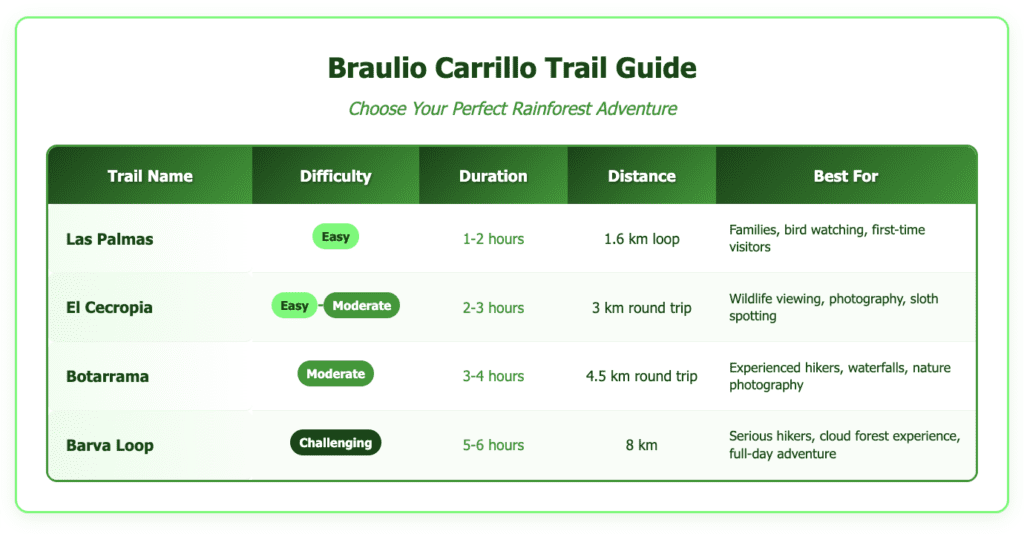
Looking for an Easy Introduction? Try Las Palmas Trail
This well-maintained loop trail provides an excellent introduction to Costa Rican rainforest without requiring extensive hiking experience, making it ideal for families.
The trail passes through secondary and primary forest sections, offering opportunities to spot various bird species, butterflies, and small mammals. Interpretive signs along the route explain forest ecology and plant identification in both Spanish and English.
The path is mostly flat with some gentle inclines, gaining only about 50 meters in elevation. It’s clear and well-marked with yellow arrows every 100 meters, though it can become muddy during rainy periods. Sturdy walking shoes with good grip are recommended – flip-flops are a recipe for slipping.
Allow 1-2 hours for a leisurely walk with stops for wildlife observation and photography. The trail’s highlight comes at the halfway point where a massive strangler fig creates a natural cathedral of roots and branches.
Want Better Wildlife Viewing? Take El Cecropia Trail
Named after the cecropia trees that attract sloths and other wildlife, this trail offers some of the park’s best opportunities for animal encounters.
Two-toed and three-toed sloths frequently rest in cecropia trees along this trail. The cecropia’s large, distinctive leaves make sloths easier to spot than in denser foliage. You might also encounter various monkey species, coatis, and over 400 bird species that inhabit the park.
Timing matters: Early morning (7-9 AM) provides the highest activity levels for most wildlife. Animals tend to be less active during the heat of midday. If you arrive at the park opening, head straight for this trail.
Photography reality: Bring a camera with zoom capabilities, as maintaining distance from wildlife is both respectful and safer. The forest canopy creates challenging lighting conditions – you’ll be shooting in deep shade with bright patches of sunlight. Consider bringing a telephoto lens if you’re serious about wildlife photography.
Ready for More Challenges? Botarrama Trail Awaits
This moderate trail rewards hikers with a spectacular waterfall view and passes through pristine primary forest. The trail descends steadily for about 2 kilometers before reaching the viewpoint.
Remember – what goes down must come back up. The return journey is all uphill, which catches many hikers off guard. Take your time and bring plenty of water.
What Wildlife Will You Actually See?
Braulio Carrillo hosts an impressive array of wildlife, though rainforest animals can be elusive and require patience to observe.
Which Animals Are Most Commonly Spotted?
Sloths: Both two-toed and three-toed sloths inhabit the park. Look for them hanging motionless in cecropia trees, particularly along El Cecropia trail during morning hours. They’re easiest to spot on sunny days after rain when they climb to treetops to dry off.
Birds: Over 400 species have been recorded here, including toucans, tanagers, hummingbirds, and various raptors. The park serves as an important stopover for migratory species. Early morning brings a dawn chorus that’s absolutely spectacular.
Monkeys: White-faced capuchin monkeys and howler monkeys are present, though encounters aren’t guaranteed. Listen for howler monkey calls, especially during early morning hours – their roar can be heard up to 3 miles away.
Other mammals: Coatis often forage near picnic areas (don’t feed them!), agoutis scurry across trails, and various bat species roost under large leaves. More elusive animals like jaguars, pumas, and tapirs inhabit remote sections but are rarely seen.
How Do You Improve Your Wildlife Spotting Chances?
Move slowly and quietly along trails. Many rainforest animals are more easily heard than seen, so developing your listening skills improves your chances of encounters.
Learn to recognize common sounds. Howler monkeys sound like wind roaring through trees. Toucans make a croaking sound. Parrots screech loudly when flying overhead. Once you know what to listen for, you’ll realize the forest is full of life.
Binoculars significantly enhance wildlife viewing opportunities. Even basic 8×32 binoculars help you spot animals in the forest canopy that would otherwise be invisible. Scan the canopy methodically rather than randomly – most animals are well-camouflaged.
Stay patient and observant. Rainforest wildlife viewing requires different skills than spotting animals in more open environments like savannas or beaches. Sometimes sitting quietly for 15 minutes reveals more than hiking quickly for an hour.
When Should You Visit Braulio Carrillo?

What Are Dry Season Advantages (December-April)?
Trail conditions are at their best during the dry season, with less mud and clearer pathways. Wildlife tends to concentrate around remaining water sources, potentially making animal encounters more likely.
Plan to arrive when the park opens (8 AM) for the best wildlife activity. Many animals are most active during cooler morning hours before the day heats up. By 10 AM, bird activity drops significantly, and mammals retreat to shade.
Clearer skies and better lighting conditions make the dry season ideal for photography, though the forest canopy still creates challenging light conditions. The lack of rain also means less mist and fog obscuring mountain views.
Why Consider Green Season (May-November)?
The rainforest comes alive during the green season, with lush vegetation, active wildlife, and dramatic waterfalls at full flow.
Morning hours typically stay dry, with rain arriving around 1-2 PM. Plan morning visits during green season, as afternoon thunderstorms are common and can make trails slippery and potentially dangerous. These afternoon downpours are actually wonderful to experience from the covered picnic areas – the sound of rain on the forest canopy is unforgettable.
Expect higher humidity and frequent rain showers, but also more active wildlife and spectacular forest conditions. Frogs and insects become much more visible, and bird breeding season means more activity and singing.
What Should You Pack for Braulio Carrillo?
Which Items Are Actually Essential?
Clothing that works: Long pants and long-sleeved shirts protect from insects and vegetation. You’ll encounter plants that can cause skin irritation, and mosquitoes are present year-round. Sturdy hiking shoes with good grip are non-negotiable – the trails can be slippery even in dry season. Bring a rain jacket or poncho regardless of season. Don’t forget a hat for sun protection in open areas.
Equipment you’ll need: Plenty of water (1-2 liters per person minimum). Snacks or lunch – there are no food services within the park. Insect repellent with DEET (apply before entering the forest). Binoculars for wildlife viewing. Camera with extra batteries (humidity drains them faster). Small first aid kit with band-aids and antiseptic.
Smart additions: Plastic bags for protecting electronics from humidity. Dry change of clothes left in your car. Towel for wiping off mud or rain. Field guide for identifying birds or plants.
Avoid bringing valuable jewelry, excessive cash, or items you can’t afford to lose or get muddy. Leave the white sneakers at home.
What Safety Considerations Matter Most?
Stay on marked trails at all times. Braulio Carrillo contains vast wilderness areas where it’s easy to become disoriented. People have gotten lost just 50 meters off the trail.
Mountain weather can change quickly. If you encounter heavy rain or fog with visibility dropping below 20 meters, consider cutting your visit short and returning another day.
Maintain distance from all wildlife. Never feed animals or attempt to approach them for photos. Even seemingly harmless animals can bite or scratch when feeling threatened.
Inform someone of your hiking plans, especially if you’re planning longer trails or visiting less popular sections of the park. Cell phone coverage is spotty to nonexistent in most areas.
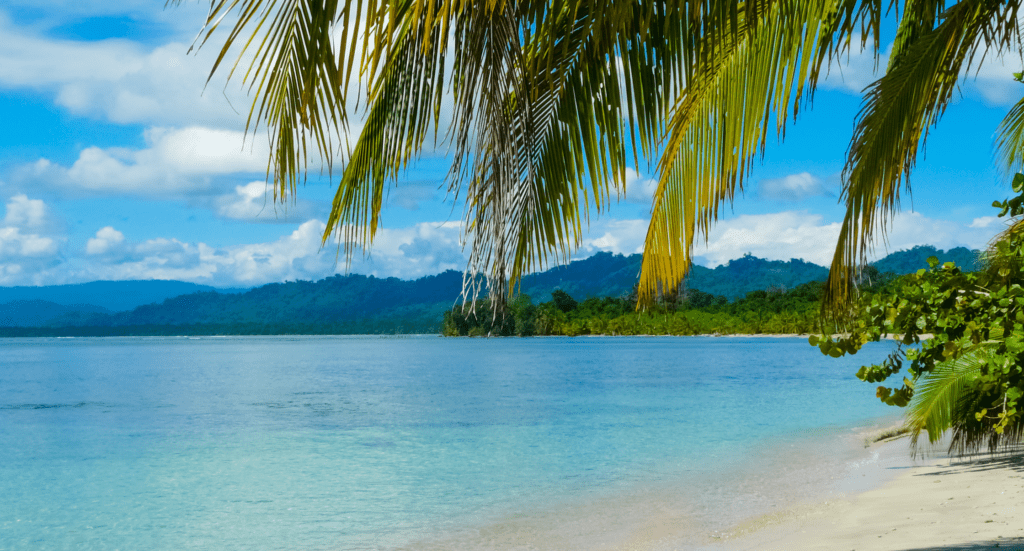
Can You Combine Braulio Carrillo with Other Stops?
Heading to the Caribbean Coast?
Braulio Carrillo’s location makes it a perfect stop when traveling to Caribbean destinations like Puerto Viejo, Cahuita, or Tortuguero. Do not leave valuables unattended in your rental vehicle.
Start early with a morning hike in Braulio Carrillo (7 AM arrival), then continue to the Caribbean coast for lunch and beach time. This combination gives you rainforest and beach experiences in a single day.
The route from Braulio Carrillo to Caribbean destinations involves continued mountain driving before reaching coastal plains. Plan for 2-3 additional hours of driving time to destinations like Tortuguero. The road descends dramatically after the park, with your ears popping from the elevation change.
Want to Stay in the Central Valley?
Combine Braulio Carrillo with other Central Valley attractions like coffee plantations, Poás Volcano, or cultural sites in San José.
A morning at Braulio Carrillo (8 AM-12 PM) leaves afternoon time for other activities without feeling rushed. Many visitors combine it with afternoon coffee tours in Heredia or Barva.
Should You Add the Aerial Tram?
The famous Rainforest Adventure aerial tram operates near Braulio Carrillo and offers a different perspective on rainforest canopy.
The tram glides silently through the canopy for about 90 minutes, with naturalist guides pointing out wildlife and explaining forest ecology. Some visitors prefer to experience the forest from ground level first (hiking trails) then see it from above (aerial tram), while others prefer the reverse order. Both approaches work well.
What Are the Practical Details You Need?
- Adults: $15 USD for international visitors
- Children under 12: Free
- Costa Rican residents: ₡2,000
- Payment accepted in USD or colones (they give change in colones)
Operating hours: 8:00 AM – 4:00 PM daily (last entry at 3:00 PM)
The park rarely reaches capacity, but arrives early for parking spots closest to trailheads. Advance reservations aren’t required for most visits, but during peak holiday periods (Christmas, Easter Week), arriving early helps ensure entry.
Basic restrooms and covered picnic areas are available at main entrances. No food services operate within the park, so bring your own meals and snacks. There’s a small shop at the Zurquí entrance selling basic drinks and snacks, but selection is limited.

How Does Having Your Own Vehicle Change the Experience?
Having reliable transportation transforms your Braulio Carrillo visit from a rushed day trip into a flexible exploration opportunity.
Why Does Timing Flexibility Matter?
With your own vehicle, you can arrive early for the best wildlife viewing opportunities and stay as long as conditions permit. Public transportation schedules often force rushed visits. If the weather turns bad, you can leave immediately rather than waiting hours for the next bus.
Carrying hiking gear, rain equipment, food, and water is much easier when you can store items securely in your vehicle rather than carrying everything on public buses. You can also leave a dry change of clothes in the car – a luxury you’ll appreciate after a humid rainforest hike.
What About Combining Destinations?
A rental car allows you to easily combine Braulio Carrillo with other destinations along the Caribbean route or Central Valley attractions, maximizing your day’s experiences.
If morning weather is perfect at Braulio Carrillo, you might decide to extend your stay. Or if clouds roll in early, you can quickly pivot to an alternative destination. This flexibility is especially valuable during the green season when weather patterns are less predictable.
The park’s location along a major highway means any vehicle type can access the main entrances easily. Standard cars work perfectly for Braulio Carrillo visits, though if you’re planning to explore multiple mountain destinations during your trip, vehicles with good acceleration help with the steep sections of Highway 32.
Ready to Discover Costa Rica's Hidden Rainforest Gem?
Braulio Carrillo offers one of Costa Rica’s most accessible rainforest experiences, perfect for travelers wanting to experience primary forest without long travel times or challenging logistics.
Start with realistic planning: Choose 1-2 trails based on your hiking experience and available time. First-time visitors often find Las Palmas trail provides an excellent introduction to Costa Rican rainforest.
Plan for weather: Regardless of season, bring rain protection and extra layers. Mountain weather can change quickly, and being prepared ensures you can enjoy your visit regardless of conditions.
Consider timing: Morning visits (8-11 AM) typically offer the best wildlife activity and most comfortable hiking conditions.
Think beyond single visits: Many travelers find Braulio Carrillo so accessible and rewarding that they return multiple times to explore different trails or experience the park during different seasons.
Ready to experience Costa Rica’s most accessible primary rainforest? Braulio Carrillo National Park provides the perfect introduction to the country’s incredible biodiversity, all within an easy drive from San José.
For more guidance on planning day trips from the capital, check out our guide to Central Valley attractions and logistics, or explore our Costa Rica road trip planning resources for combining multiple destinations efficiently.
The rainforest is waiting – and it’s closer than you think.


